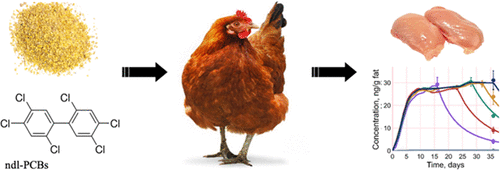当前位置:
X-MOL 学术
›
Environ. Sci. Technol.
›
论文详情
Our official English website, www.x-mol.net, welcomes your
feedback! (Note: you will need to create a separate account there.)
Unraveling Congener-Specific Transfer of Non-Dioxin-Like Polychlorinated Biphenyls (ndl-PCBs) from Feed into Chicken Meat
Environmental Science & Technology ( IF 10.8 ) Pub Date : 2021-08-03 , DOI: 10.1021/acs.est.1c02650 Britta Ohlhoff 1 , Daria Savvateeva 1 , Thorsten Bernsmann 2 , Markus Spolders 1 , Anne Jahnke 1 , Anja Lüth 1 , Monika Lahrssen-Wiederholt 1 , Jorge Numata 1 , Robert Pieper 1
Environmental Science & Technology ( IF 10.8 ) Pub Date : 2021-08-03 , DOI: 10.1021/acs.est.1c02650 Britta Ohlhoff 1 , Daria Savvateeva 1 , Thorsten Bernsmann 2 , Markus Spolders 1 , Anne Jahnke 1 , Anja Lüth 1 , Monika Lahrssen-Wiederholt 1 , Jorge Numata 1 , Robert Pieper 1
Affiliation

|
Non-dioxin-like polychlorinated biphenyls (ndl-PCBs) are a subclass of persistent bioaccumulative pollutants able to enter the food chain. We investigated the transfer of ndl-PCBs from contaminated feed into meat and liver of fattening chickens. A total of 48 chicks were divided into five treatment and one control groups. Treated animals were fed with contaminated diets (11.7 ± 0.4 μg/kg sum of indicator ndl-PCBs; 88% dry matter (DM)) before slaughter for different subperiods of time: 16, 23, 28, 32, and 36 days for groups 1–5, respectively. One day after the end of each subperiod, three animals per group were slaughtered to determine the congener-specific ndl-PCB content. All remaining animals were fed the control feed until slaughter on day 37 to probe depuration. We used these data to generate congener-specific physiologically based toxicokinetic (PBTK) models for indicator ndl-PCBs. The models show that PCBs 28, 138, 153, and 180 form a more slowly eliminated cluster (with an observed transfer rate into meat over 74% and observed half-lives over 8.7 days) than PCBs 52 and 101 (with a transfer rate under 13% and half-lives under 2.6 days). Our simulations show that ndl-PCB levels in feed lower than 3.9 (long 56-day) or 4.4 μg/kg (short 37-day fattening period) would be necessary to ensure the current maximum level in muscle meat (fat basis), according to EU Regulations 1881/2006 and 1259/2011. The PBTK models are made available in the Python and Food Safety Knowledge Exchange formats.
中文翻译:

揭示非二恶英类多氯联苯 (ndl-PCBs) 从饲料到鸡肉的同系物特异性转移
非二恶英类多氯联苯 (ndl-PCBs) 是能够进入食物链的持久性生物累积污染物的一个子类。我们调查了 ndl-PCBs 从受污染的饲料转移到育肥鸡的肉和肝脏中。共48只小鸡被分为5个治疗组和1个对照组。经处理的动物在屠宰前喂食受污染的饮食(11.7 ± 0.4 μg/kg 指示剂 ndl-PCB 总和;88% 干物质 (DM))在不同的亚时期内:16、23、28、32 和 36 天的组1-5,分别。每个亚周期结束后一天,每组屠宰三只动物以确定同源物特异性 ndl-PCB 含量。所有剩余的动物都喂食对照饲料直到第 37 天屠宰以探测净化。我们使用这些数据为指示剂 ndl-PCB 生成基于同源物的特定生理毒代动力学 (PBTK) 模型。模型显示 PCB 28、138、153 和 180 形成一个比 PCB 52 和 101(转移率低于13%,半衰期低于 2.6 天)。我们的模拟表明,饲料中 ndl-PCB 水平低于 3.9(长 56 天)或 4.4 μg/kg(短 37 天育肥期)对于确保当前肌肉肉(脂肪基础)中的最高水平是必要的。欧盟法规 1881/2006 和 1259/2011。PBTK 模型以 Python 和食品安全知识交换格式提供。和 180 形成比 PCB 52 和 101(转移率低于 13%,半衰期低于 2.6 天)更慢地消除的簇(观察到转移到肉中的速度超过 74%,观察到的半衰期超过 8.7 天)。我们的模拟表明,饲料中 ndl-PCB 水平低于 3.9(长 56 天)或 4.4 μg/kg(短 37 天育肥期)对于确保当前肌肉肉(脂肪基础)中的最高水平是必要的。欧盟法规 1881/2006 和 1259/2011。PBTK 模型以 Python 和食品安全知识交换格式提供。和 180 形成比 PCB 52 和 101(转移率低于 13%,半衰期低于 2.6 天)更慢地消除的簇(观察到转移到肉中的速度超过 74%,观察到的半衰期超过 8.7 天)。我们的模拟表明,饲料中 ndl-PCB 水平低于 3.9(长 56 天)或 4.4 μg/kg(短 37 天育肥期)对于确保当前肌肉肉(脂肪基础)中的最高水平是必要的。欧盟法规 1881/2006 和 1259/2011。PBTK 模型以 Python 和食品安全知识交换格式提供。根据欧盟法规 1881/2006 和 1259/2011,需要 4 μg/kg(短 37 天育肥期)以确保当前肌肉肉(脂肪基础)的最高水平。PBTK 模型以 Python 和食品安全知识交换格式提供。根据欧盟法规 1881/2006 和 1259/2011,需要 4 μg/kg(短 37 天育肥期)以确保当前肌肉肉(脂肪基础)的最高水平。PBTK 模型以 Python 和食品安全知识交换格式提供。
更新日期:2021-08-17
中文翻译:

揭示非二恶英类多氯联苯 (ndl-PCBs) 从饲料到鸡肉的同系物特异性转移
非二恶英类多氯联苯 (ndl-PCBs) 是能够进入食物链的持久性生物累积污染物的一个子类。我们调查了 ndl-PCBs 从受污染的饲料转移到育肥鸡的肉和肝脏中。共48只小鸡被分为5个治疗组和1个对照组。经处理的动物在屠宰前喂食受污染的饮食(11.7 ± 0.4 μg/kg 指示剂 ndl-PCB 总和;88% 干物质 (DM))在不同的亚时期内:16、23、28、32 和 36 天的组1-5,分别。每个亚周期结束后一天,每组屠宰三只动物以确定同源物特异性 ndl-PCB 含量。所有剩余的动物都喂食对照饲料直到第 37 天屠宰以探测净化。我们使用这些数据为指示剂 ndl-PCB 生成基于同源物的特定生理毒代动力学 (PBTK) 模型。模型显示 PCB 28、138、153 和 180 形成一个比 PCB 52 和 101(转移率低于13%,半衰期低于 2.6 天)。我们的模拟表明,饲料中 ndl-PCB 水平低于 3.9(长 56 天)或 4.4 μg/kg(短 37 天育肥期)对于确保当前肌肉肉(脂肪基础)中的最高水平是必要的。欧盟法规 1881/2006 和 1259/2011。PBTK 模型以 Python 和食品安全知识交换格式提供。和 180 形成比 PCB 52 和 101(转移率低于 13%,半衰期低于 2.6 天)更慢地消除的簇(观察到转移到肉中的速度超过 74%,观察到的半衰期超过 8.7 天)。我们的模拟表明,饲料中 ndl-PCB 水平低于 3.9(长 56 天)或 4.4 μg/kg(短 37 天育肥期)对于确保当前肌肉肉(脂肪基础)中的最高水平是必要的。欧盟法规 1881/2006 和 1259/2011。PBTK 模型以 Python 和食品安全知识交换格式提供。和 180 形成比 PCB 52 和 101(转移率低于 13%,半衰期低于 2.6 天)更慢地消除的簇(观察到转移到肉中的速度超过 74%,观察到的半衰期超过 8.7 天)。我们的模拟表明,饲料中 ndl-PCB 水平低于 3.9(长 56 天)或 4.4 μg/kg(短 37 天育肥期)对于确保当前肌肉肉(脂肪基础)中的最高水平是必要的。欧盟法规 1881/2006 和 1259/2011。PBTK 模型以 Python 和食品安全知识交换格式提供。根据欧盟法规 1881/2006 和 1259/2011,需要 4 μg/kg(短 37 天育肥期)以确保当前肌肉肉(脂肪基础)的最高水平。PBTK 模型以 Python 和食品安全知识交换格式提供。根据欧盟法规 1881/2006 和 1259/2011,需要 4 μg/kg(短 37 天育肥期)以确保当前肌肉肉(脂肪基础)的最高水平。PBTK 模型以 Python 和食品安全知识交换格式提供。











































 京公网安备 11010802027423号
京公网安备 11010802027423号